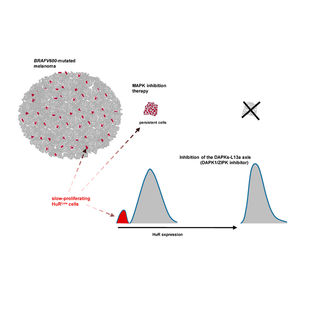Neuro-degeneration as a result of disbalanced biochemical equilibrium
Recent insights of Prof. Anna von Mikecz, scientist at the IUF-Leibniz Research Institute for Environmental Medicine, shed new light on the development of protein aggregating diseases, e.g. Alzheimer’s, Parkinson’s and Huntington’s disease.
Anna von Mikecz, leader of the IUF group Influence of xenobiotics on the cell nucleus, focuses her research on the functional role of clumped, i.e. aggregated, proteins, also called amyloid, in the cell nucleus. As reported in her new scientific paper*, amyloid occurs also in healthy human cells and nuclei, and plays probably an important functional role.
Amyloids are formed by fibrillation of proteins. The main focus in the field of pharmacology lays on the pathological aspects of amyloids and countermeasures against neurodegenerative diseases today aim at the prevention of amyloid formation. Prof. von Mikecz comments the assumption that amyloid formation is in general adverse, as follows: “This hypothesis is currently discussed controversially among scientists and it is becoming increasingly clear that we do not yet understand the molecular mechanisms of amyloid formation in the cell well enough.”A better understanding of the physiological and functional role of amyloids in the nucleus is a prerequisite for promising therapeutic interventions in neurodegenerative protein deposition diseases.”
The scientist’s results indicate that there is a tipping point for the adverse effect of amyloid in the nucleus, i.e. if a critical amount of amyloid in the nucleus is exceeded, harmful neuro-degenerative effects result. Her research also shows that the amyloid equilibrium is disbalanced by exposure to xenobiotics such as certain nano-particles and heavy metals. The exposure leads to an increase in the amount of amyloid in the nucleus above the critical amount. This can be observed in vivo in animal studies as well as in vitro in cell cultures.
It is to be expected, that this new concept will facilitate the development of original diagnostic approaches, bring us significantly closer to effective countermeasures and also contribute to understanding the relationship between exposure to xenobiotics and the development of neuro-degenerative diseases.
Original publication
Anna von Mikecz; "Pathology and function of nuclear amyloid: protein homeostasis matters."; Nucleus (2014)
Most read news
Other news from the department science

Get the life science industry in your inbox
By submitting this form you agree that LUMITOS AG will send you the newsletter(s) selected above by email. Your data will not be passed on to third parties. Your data will be stored and processed in accordance with our data protection regulations. LUMITOS may contact you by email for the purpose of advertising or market and opinion surveys. You can revoke your consent at any time without giving reasons to LUMITOS AG, Ernst-Augustin-Str. 2, 12489 Berlin, Germany or by e-mail at revoke@lumitos.com with effect for the future. In addition, each email contains a link to unsubscribe from the corresponding newsletter.




















































